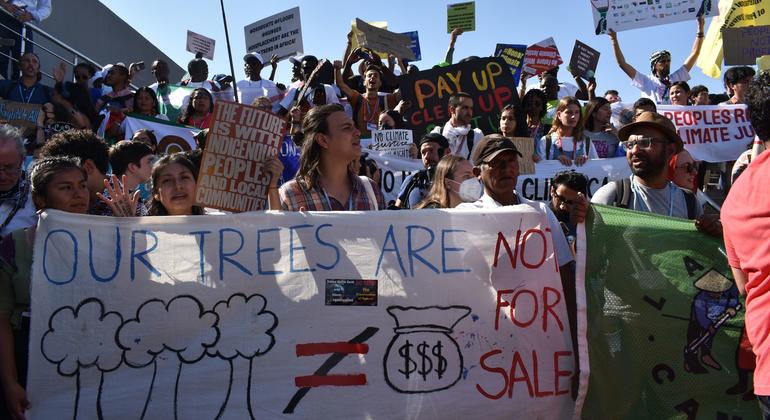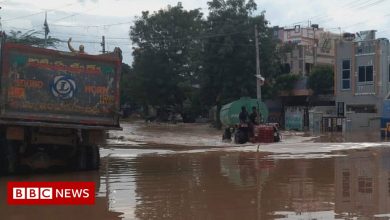Adapt or starve: COP27 highlights agriculture’s challenges and solutions in the face of climate change |

This sentiment echoed through dozens of booths and conference rooms in Sharm el-Sheikh on Saturday as COP27 turned its attention to key issues of Adaptation systems, agriculture and food in the context of climate change.
“We need to help rural people build resilience to extreme weather events and adapt to climate change. Otherwise, we just go from one crisis to another. Sabrina Dhowre Elba, United Nations International Fund for Agricultural Development Goodwill Ambassador ()IFAD), said in a press conference.
As a Somali woman, Dhowre Elba says the issue is personal: when COP27 started, her country experienced four consecutive failed rainy seasons, a climate event not seen in 40 years. .
“I cannot stand idly by as mothers, families and farmers are suffering across the Horn of Africa as the region experiences its most severe drought in recent history,” she explains. at the same time calling on developed countries to mobilize political will and investment.
“Trillions of dollars have been offered to settle COVID-19 pandemic and its economic consequences. The same is true for climate change. This is also needed to support sustainable agriculture. It is vital to the well-being and food security of all of us,” she added.

Farmers in western Nepal are learning to deal with higher temperatures and different rainfall patterns.
Funds for adaptation must be transferred
Dina Saleh, IFAD Regional Director, explains that failing to help rural people adapt can have dangerous consequences, leading to longer-lasting poverty, migration and conflict.
This is why today we are calling on world leaders from the developed world to honor their commitment to provide $100 billion in climate finance each year to developing countries. develop and convert half of it to climate adaptation”.
Thirteen years ago, at COP15 Copenhagen, developed countries have made an important commitment. They promised to transfer $100 billion a year to less affluent nations by 2020, to help them adapt to climate change and mitigate temperature rises. However, that promise was not kept.
Ms. Saleh warned that there is a “narrow window” to help the rural poor survive and protect their communities, and crop yields could drop by as much as 50% by the end of this century.
“The choice is between adapting or starving,” she warned, calling for COP27 to work towards action, credibility and justice for the invisible and silent.

Vegetables are prepared for an agricultural training session for farmers in Taita, Kenya.
A new initiative
Precisely to solve these problems, the President of COP27 Egypt launched a new initiative on Friday Food and Agriculture for a Sustainable Transformation or FAST, to improve the quantity and quality of climate finance contributions to transform food and agriculture systems by 2030.
The partnership will have concrete outcomes to help countries access climate finance and investment, increase knowledge, provide support and policy dialogue.
Food and Agriculture Organization of the United Nations (FAO), along with other UN agencies, will be the facilitators of this initiative, according to Zitouni Ould-Dada, Deputy Director of the agency’s Climate and Environment Division, which puts agriculture at the heart of the initiative. of efforts to tackle climate change.
“The real message is to recognize that agriculture must be an integral part of the solution to the climate crisis,” he told UN News.
The importance of investing in innovation
At the same time, while the agriculture and food sectors are deeply impacted by climate change, it also contributes about a third of global greenhouse gas emissions, from production to consumption, said Ould-Dada explain and argue that there is a need for a transformation of the agro-food system.
“It is not possible to continue the current food production model and then degrade the soil, reduce biodiversity, and affect the environment. No. It has to be sustainable,” he noted.
The expert emphasized that with the right choices, agriculture can be an important part of the solution to the climate crisis by sequestering carbon in soils and plants, and promoting adaptation and resilience. recovery capacity.
“We cannot produce food to feed and feed a growing population with the current model, with the threat of climate change. We can not. “
The first thing the world should tackle, he said, is to tackle food waste, which accounts for 8% of global emissions.
“We have about 828 million hungry people every day. And yet, we throw away a third of the food we produce for human consumption. We need to change our thinking and production models so that we don’t lose or waste food,” he stressed.
He added that in terms of solutions, harnessing the power of innovation is crucial to reducing emissions, helping agriculture adapt to a changing climate and making it more resilient to adversity, not not only by climate change but also by pandemics or wars, such as the current situation in Ukraine.
“Innovation in a broader sense like precision farming where you have a drip irrigation system combined with renewable energy for you to be efficient. But beyond that, innovation that taps into the traditional knowledge of smallholder farmers is also important, as it happens all the time,” emphasized Mr. Ould-Dada.

Activists mass protest at COP27 in Sharm El-Sheikh demanding that leaders do more to address important issues related to agriculture, climate adaptation and resilience.
Civil society calls for finance, transforming the economy
The United Nations representatives are not the only ones stressing the need for countries to invest in transition and deliver on their climate finance promises.
A massive protest led by a coalition of environmental organisations, women, indigenous peoples, youth and trade unions occupied the streets and aisles between pavilions at COP27.
“Rights to territory, rights to resources, human rights, rights of indigenous peoples, loss and damage must be included in all negotiated documents…. Hindou Oumarou Ibrahim, Chadian environmentalist and Supporter of SDG.
The activist says her people are dying from floods and droughts, while some indigenous communities in the Pacific are losing their homeland.
“We want justice. Justice for our people, for our economy for the loss and damage. We are losing our culture, our identity, our lives and these cannot be paid for, but climate finance needs to be provided,” she shouted among hundreds of protesters.

Young activists at COP27 in Sharm El-Sheikh ask developed countries to ‘pay the price’ for the loss and damage caused by climate change.
‘This COP is lost and damaged’
Meanwhile, prominent Nigerian activist Nnimmo Basse argued that COP27 was “lost and damaged” by allowing major polluters to participate.
“Africa is currently under attack. Mining and oil companies sink their dirty machines across the continent to destroy, kill, steal. This is the kind of colonialism that cannot be tolerated,” he said, shortly before inspiring participants to chant “no fossil fuel colonialism.”
Mr. Basse said that if nations can spend two trillion dollars a year on war, destruction and killing, they can spend it to pay for resilience.
“We’re not asking for one at $100 billion. We’re not asking for $200 billion. We are asking for a debt owed and must be repaid. Pay the climate debt,” he asked world leaders.
America says ready to help
Late Saturday, John Kerry, the United States Special Envoy for Climate Action, told a news conference that his country “fully supports” efforts to address loss and damage. corner to date in the COP27 negotiations.
“We joined our friends to work through the proposals,” he added, noting that US President Joe Biden, whom NGOs had called on Friday for not mentioning loss and damage in his speech at COP27, also supported the move.
Negotiating Group 77 and China, which includes essentially all developing countries, could put the issue on the agenda of this year’s COP for the first time.
The idea is to create a The loss and damage financial facility can provide monetary compensation to countries most affected by climate change, but is less responsible for greenhouse gas emissions.
You want to know more? our test special events pagewhere you can find all of our news about the COP27 climate summit, including stories and videos, explainers, podcasts and our daily newsletter.




